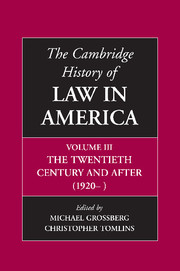Book contents
- Frontmatter
- 1 Law and the State, 1920–2000: Institutional Growth and Structural Change
- 2 Legal Theory And Legal Education, 1920–2000
- 3 The American Legal Profession, 1870–2000
- 4 The Courts, Federalism, and The Federal Constitution, 1920–2000
- 5 The Litigation Revolution
- 6 Criminal Justice in the United States
- 7 Law and Medicine
- 8 The Great Depression and the New Deal
- 9 Labor’s Welfare State: Defining Workers, Constructing Citizens
- 10 Poverty law and income Support: From the Progressive Era to the War on Welfare
- 11 The Rights Revolution in the Twentieth Century
- 12 Race and Rights
- 13 Heterosexuality as a Legal Regime
- 14 Law and the Environment
- 15 Agriculture and the State, 1789–2000
- 16 Law and Economic Change During the Short Twentieth Century
- 17 The Corporate Economy: Ideologies of Regulation and Antitrust, 1920–2000
- 18 Law and Commercial Popular Culture in the Twentieth-Century United States
- 19 Making Law, Making War, Making America
- 20 Law, Lawyers, and Empire
- Bibliographic Essays
- Notes on Contributors
- Index
- References
4 - The Courts, Federalism, and The Federal Constitution, 1920–2000
Published online by Cambridge University Press: 28 November 2008
- Frontmatter
- 1 Law and the State, 1920–2000: Institutional Growth and Structural Change
- 2 Legal Theory And Legal Education, 1920–2000
- 3 The American Legal Profession, 1870–2000
- 4 The Courts, Federalism, and The Federal Constitution, 1920–2000
- 5 The Litigation Revolution
- 6 Criminal Justice in the United States
- 7 Law and Medicine
- 8 The Great Depression and the New Deal
- 9 Labor’s Welfare State: Defining Workers, Constructing Citizens
- 10 Poverty law and income Support: From the Progressive Era to the War on Welfare
- 11 The Rights Revolution in the Twentieth Century
- 12 Race and Rights
- 13 Heterosexuality as a Legal Regime
- 14 Law and the Environment
- 15 Agriculture and the State, 1789–2000
- 16 Law and Economic Change During the Short Twentieth Century
- 17 The Corporate Economy: Ideologies of Regulation and Antitrust, 1920–2000
- 18 Law and Commercial Popular Culture in the Twentieth-Century United States
- 19 Making Law, Making War, Making America
- 20 Law, Lawyers, and Empire
- Bibliographic Essays
- Notes on Contributors
- Index
- References
Summary
The history of American federalism in the twentieth century falls into three distinct periods. The era of post-Reconstruction federalism, which began in the late nineteenth century, ended in the years after 1929 when a shattering series of domestic and international crises combined with the innovative presidency of Franklin D. Roosevelt to reorient the nation’s laws, politics, and institutions. The resulting “New Deal Order” lasted for almost five decades before crumbling in the century’s last quarter when massive social, cultural, economic, and political changes combined with the dramatizing presidency of Ronald Reagan to begin reorienting the system once again. At century’s end, the nature and course of that emerging era remained unsettled.
THE NATURE AND DYNAMICS OF AMERICAN FEDERALISM
With a de facto default rule favoring decentralization, American federalism is a governmental system based on the existence of independent political power at both state and national levels. Its essence lies, first, in the institutional tensions that the Constitution structured between the two levels of government, and second, in the complex processes of decision making that the Constitution established to maintain satisfactory relations between the two levels. Those processes were complex because they involved, on the national side, three distinct and counterpoised branches of government and, on the state side, a growing multitude of equal, independent, and often conflicting governing units. In theory, and sometimes in practice, national power served to foster economic integration and efficiency, facilitate the development and enforcement of desirable uniform standards, enable the people to deal effectively with problems national and international in scope, protect the security and general welfare of the nation as a whole, and safeguard liberty by checking the potential tyranny of local majorities.
- Type
- Chapter
- Information
- The Cambridge History of Law in America , pp. 127 - 174Publisher: Cambridge University PressPrint publication year: 2008



